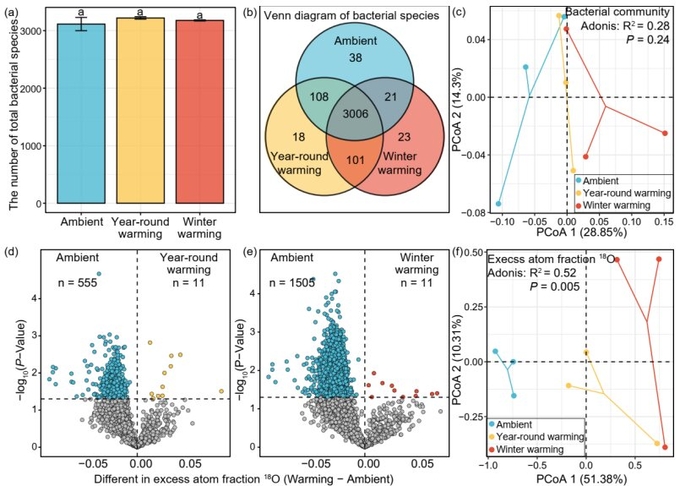October 29, 2025 | 07:29 GMT +7
October 29, 2025 | 07:29 GMT +7
Hotline: 0913.378.918
October 29, 2025 | 07:29 GMT +7
Hotline: 0913.378.918

Variation in bacterial community composition and excess atom fraction 18O of bacterial species.
A team of Earth scientists at Lanzhou University, working with a group of organic chemists from Nanjing Agricultural University and another colleague from Tsinghua University, all in China, has found that asymmetric climate warming reduces the ability of soil to sequester carbon more than symmetric warming. The findings are published in the Proceedings of the National Academy of Sciences.
Prior research has shown that the Earth is undergoing asymmetric global warming—more warming is experienced during winters than in summers. In this new effort, the researchers point out that few climate models take the asymmetric nature of warming into account, which is likely skewing the results.
To better understand the difference asymmetric warming might make, they began a decade-long study on the Tibetan plateau, where they artificially controlled temperatures on patches of ground over the years between 2011 and 2020. Some patches were left un-warmed; some were exposed to temperatures 2°C warmer than normal all throughout the year; others were warmed from 2.5 to 2.8°C more in the winter and 0.5 to 0.8°C more during the rest of the year. After 10 years, they tested the soil to see the impact of warming.
The first soil test involved measuring the growth rate of microbes in the soil, while the second tested carbon use efficiency. The first test was to determine whether the microbes use carbon from the air to grow. The second test measured the amount of CO2 microbes respirated back into the air. Prior research has suggested that soil microbes tend to bulk up more under colder temperatures and thus respire less CO2.
The research team found that the soil heated symmetrically saw a decline in growth rates of 31% and a decline in efficiency of 22%. They also found worse conditions for the soil exposed to asymmetric heating—there, the declines in growth rate were 58% and 81% for efficiency.
The researchers suggest asymmetric warming is reducing carbon absorption rates in cold regions such as the poles and mountaintops—a finding that should be reflected in climate models.
(Phys.org)

(VAN) Latest Global Forest Resources Assessment provides detailed analyses for 236 countries and areas.

(VAN) Bleak report finds greenhouse gas emissions are still rising despite ‘exponential’ growth of renewables.

(VAN) Europe’s animal welfare overhaul is on life support. Denmark’s farm minister thinks he can still revive it - one compromise at a time.

(VAN) CNPO’s board of directors has unanimously decided to end the interprofessional agreement, almost a year before the official expiry date of September 2026.

(VAN) Before moving to Thailand two years ago, I had never tried durian - the spiky fruit that has become so popular among adventurous Chinese eaters.

(VAN) Commitments and next steps to be presented at the World Urban Forum in Baku 2026.

(VAN) The Agriculture Department will reopen about 2,100 county offices all across the country Thursday despite the ongoing government shutdown to help farmers and ranchers get access to $3 billion of aid from existing programs.